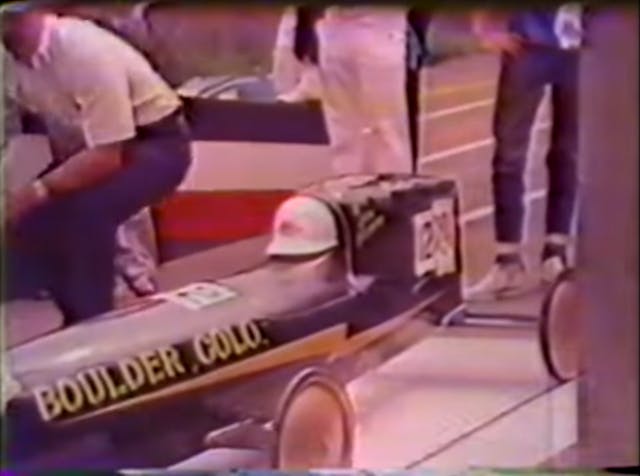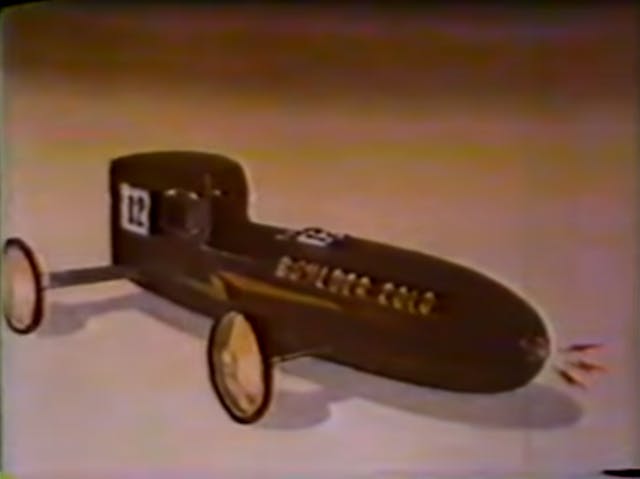Media | Articles
You don’t need horsepower to cheat: The 1973 Soap Box Derby championships
“In the year of Watergate, the derby too fell victim to cynical adults for whom victory justified any means,” narrator Peter Thomas states boldly. The year is 1973, and the scandal we’re about to discuss involved hidden secrets, intense investigations, and a reckoning that few expected—oh, and they also tried impeaching Richard Nixon, but that was child’s play compared to what happened at the start line of the 36th annual All-American Soap Box Derby.
Powered only by gravity, soap box race cars get their name from their 1930s roots, when they featured bodywork constructed from the boards of soap boxes. By the ’70s, the derby had grown into a professional motorsport just the same as the motored race cars many kids were destined to pilot, with sponsorships and prize money on the line as racers won bracket-style eliminations at local races in order to gain a spot at the big-shot championship in Akron, Ohio. Rulebooks had grown faster than the children they were written for as adults meddled with the soap box cars to gain an advantage any way they possibly could. Not unlike the smaller pinewood derby cars many people are familiar with, modified wheels and axles were the quickest ways to gain speed by reducing friction wherever possible. Lighter children were seen as advantageous, as they could have more freedom on where to place additional ballast to meet the minimum weight requirement. But with all the subtle tricks rising the tide of “fair competition,” few were as remembered as damning as the magnetic nose of Jimmy Gronen’s streamlined derby car.
The 14-year-old Jimmy and his uncle, Robert Lange, were from Boulder, Colorado, and they had entered a derby car based on the previous year’s championship-winning design piloted by Jimmy’s cousin. With over 130 entrants from all over the world—including Venezuela, West Germany, and Canada—the thunderbolt on the side was a right on the nose, given what was hiding at the front of the derby car, but few could figure out why the car was mysteriously launching off the line quicker than its competition.

Initially, officials went to the quick fixes to power balance the car. Some had said that they buffed the tires, so a new set was required while weight was drilled out of the car by another official. Still, Jimmy’s derby car seemed oddly unstoppable. There was something “strange about Jimmy’s fiberglass car,” the narrator says. “It seems to leap across the starting line when the metal flap is dropped.”
Jimmy’s title victory over Diane Skrzypek and Bret Yarborough in the finale was met with boos, which reverberated as low as the mood over the podium in Akron that day. Although reading between the lines was a part of the game, the accusations being tossed around began to escalate beyond a little extra polishing of the wheels.
Marketplace
Buy and sell classics with confidence
People were bringing photos (presumably Polaroids) to officials showing that the cheating derby car was gaining its advantage at the front of the run, which was unusual, and the gaps at the finish were markedly larger than typical. Soap box racing is on a fair power source after all—gravity. These things can only go so fast and stay with in the rules.
Even though Jimmy was crowned the winner, the Derby National Control Board, which sanctioned the All-American Soap Box Derby, took the suspicious machine to be X-rayed as if it were smuggling contraband—and by Derby National Control Board standards, they certainly found some. A switch behind the headrest applied battery power to an electromagnet in the nose of the derby car, which pulled it against the start-line flap as it dropped forward. This accounted for the gap that people were noting at the start of the run, and created the sling-shot effect needed to drive the massive margins of victory.


“Is nothing sacred any more? Is there no area of American life beyond taint?” Time magazine exclaimed. A prosecutor in Ohio apparently said, “It’s like seeing apple pie, motherhood, and the American flag grinding to a halt.” Soap box racing, despite the undertone of seeking unfair advantages, was seen as a pure and untarnished element of Americana. The derby cars, presumably built by the children, was supposed to encourage craftsmanship as much as sportsmanship, and here was an egregious attempt to secure a national title through unscrupulous means. The trouble didn’t stop in Ohio; a district attorney in Boulder, Colorado, the family’s hometown, also became involved. Allegedly, the car was hidden but was eventually tracked down in Oklahoma while Robert Lange was at a horse show.
“It’s not like the Soap Box Derby at this time was this pristine, pure thing and then my year came along and it was transformed by my corrupt act,” Jimmy said in a 2003 book titled Champions, Cheaters and Childhood Dreams: Memories of the Soap Box Derby. “The derby was corrupt before we arrived.”
Ultimately, the story was more complicated than it seemed on the surface, though the means were found to have not justified this drama’s ultimate end. Lange admitted to masterminding the whole thing, suggesting it to Jimmy during the build of the derby car. Lange had recently taken custody of his nephew, as Jimmy’s father was no longer alive and his mother was hospitalized, and he wanted to give him an advantage. While the intent was to give Jimmy a morale boost, the effect in competition did the opposite. He wasn’t just faced with boos at the podium, but he was disqualified and lost the grand prize, a $7500 scholarship, which adjusted for inflation was worth nearly $44,000 today. Lange, who worked to bare the brunt of the flack, was also asked to pay $2000 to the Boys Club of Boulder as a moral punishment, and he was banned from derby competition for two years.
Colis Yarborough, whose son, Chris, was awarded first place after Jimmy was disqualified, told the Beacon Journal after the race, “I feel terrible for the kid. It’s just terrible that he had to go through something like this. The kid was fantastic.” As the story goes, when Jimmy returned to the scene, he was largely supported while Lange was eternally admonished for corrupting the sport.
Every aspect of this story echoes in other forms of motorsport, from the rising costs and complexity putting the intent of the sport in question, to the pot-calling-kettle-black situation of finding a better cheater than yourself. The travesty here is that a 14-year-old was pulled into the greyed morals of jaded adults in a year that presumably was already one of the toughest he’d had, considering his parents’ situation.
“I wonder if Soap Box Derby racing, car racing, bicycle racing really develops the soul,” Jimmy said in a rare interview with the Beacon Journal in 2013. By and large, Jimmy had checked out of his past life in the 40 years since the race, leading a life of spirituality under a new name. “When there’s money and prestige involved, you can almost bet that the ethics are questionable.”
The “world’s most infamous derby car” is much less elusive. You can see it in the Soap Box Derby Museum in Arkon.












If you want to talk about cheating look at what goes on in the Pinewood Derby. It ain’t pretty!!!